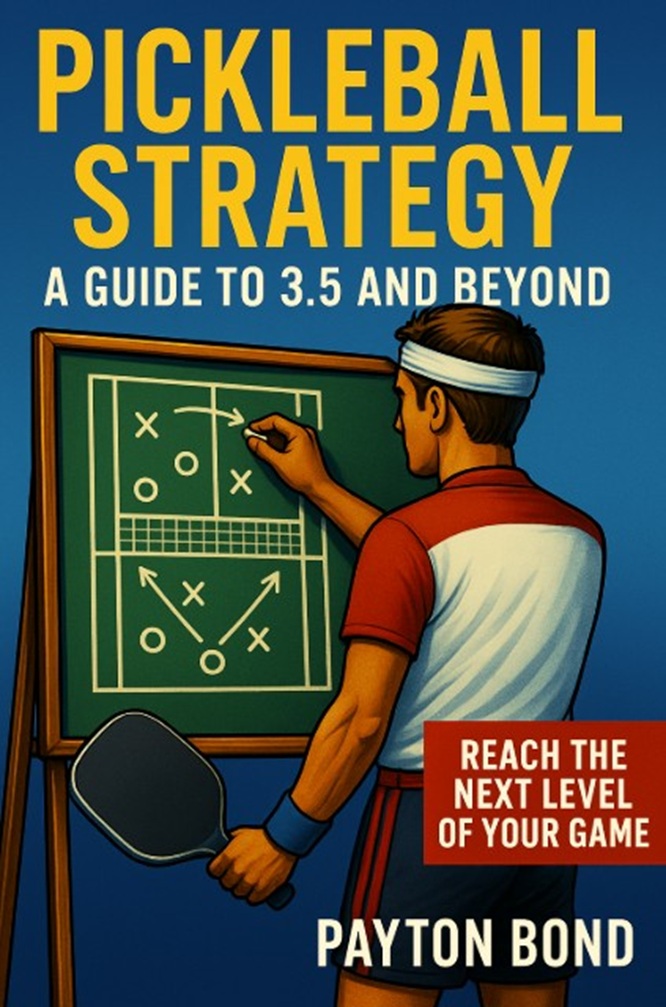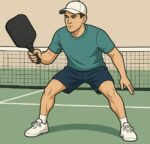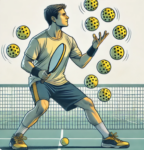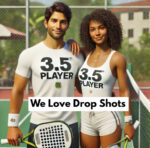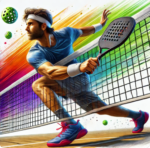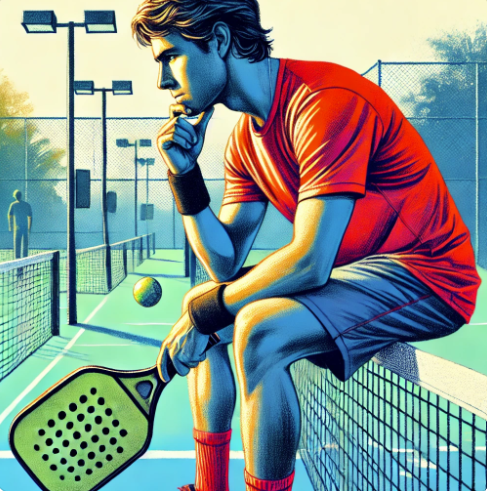
The pickleball backhand shot is used less frequently in pickleball, as in any racquet sport, because it is generally a weaker shot and less natural to execute.
The forehand shot utilizes larger and stronger muscle groups, particularly the chest, shoulders, and the dominant arm’s biceps and triceps. With a forehand shot, players can rotate their bodies more effectively, engaging their hips and core to add power. The natural swing path of a forehand shot also allows for a longer follow-through, which helps in generating more speed and power.
Backhand Shot Mechanics
Preferred Grip
Eastern Backhand Grip: Offers control and power while facilitating topspin. This grip keeps your paddle face slightly closed (tilted forward), which is ideal for maintaining low and controlled shots.
Stance and Preparation
- Feet Position: Stand with feet shoulder-width apart. Position your dominant foot slightly forward to enable a smooth swing and stable base.
- Body Alignment: Turn your body sideways to the net, with your dominant shoulder facing the target.
- Knee Flexion: Slightly bend your knees and maintain a low center of gravity to improve balance and control.
- Paddle Position: Hold your paddle at waist level, with the paddle face slightly closed for better control and topspin.
Backswing
- Take a full backswing, bringing the paddle back to your non-dominant side to generate power.
- Avoid short backswings, as they reduce momentum and power.
- Ensure the paddle face stays stable and slightly closed during the backswing for better ball control.
Swing Technique
- Weight Transfer:
- Shift your weight from your back foot to your front foot as you swing forward.
- This weight transfer generates power and keeps the shot stable.
- Contact Point:
- Strike the ball in front of your body for optimal control and accuracy.
- Move the paddle in a forward and slightly upward direction to add topspin.
- Follow-Through:
- Extend your paddle toward the target, guiding the ball.
- Finish high, with your dominant shoulder rotating naturally through the shot.
Wrist Position
- Do Not Flick the Wrist:
- Flicking the wrist leads to inconsistency, loss of control, and weaker shots.
- Maintain a firm but relaxed grip to keep the paddle face stable throughout the swing.
- Focus on Shoulder and Arm Movement:
- Generate power through your shoulder, arm, and body rotation rather than relying on wrist movement.
- A stable wrist ensures precision and consistency in your shot.
By combining the proper grip, stance, full backswing, and stable wrist, your backhand shot can become a reliable and powerful weapon in your pickleball game. Avoid wrist flicking, focus on smooth body mechanics, and practice your follow-through to achieve consistent and effective backhand shots.
Watch the video at the end of this post for a great review of the backhand shot.
In pickleball, opponents often target your backhand because it is typically weaker. This strategy is most common during the serve and return of serve, as these are controlled shots.
Targeting Opponents’ Backhands
Targeting your opponent’s backhand while minimizing the use of your own is a significant part of doubles strategy. For example:
- Stacking: Position players to always have a strong forehand in the middle.
- Stepping In: Communicate and step in front of your partner to play a forehand instead of allowing them to play their backhand.
Primary Focus: Volleys and Cross-Court Dinks
Much of the backhand shot use in pickleball involves:
- Volleys at the Kitchen Line: Short-distance, short-swing backhand volleys are easy to master and frequently used during points.
- Cross-Court Dinks: These controlled, short backhand shots are also essential.
These types of shots will be your primary focus for backhand practice, as they are fundamental to gameplay.
Practicing Long-Distance Backhand Shots
Although less common, you should also practice longer-distance backhand shots. These are needed primarily in situations such as:
- Return of Serve:
- If the server effectively targets your backhand, use a longer backhand stroke to return the serve.
- Your goal is to hit the ball deep, as the serving team must let the ball bounce.
- Tip: Always try to use your forehand for serve returns, but practice the backhand for when it’s unavoidable.
Backhand on the 3rd Shot
In some situations, you may need to use a backhand for the 3rd shot.
When forced to use a backhand for the 3rd shot:
- Focus on Backhand Drop Shots:
- These require less swing or power.
- They are easier to control and can neutralize opponents’ aggression.
Developing Effective Backhand Shots
Hitting effective backhand shots comes with:
- Practice: Regularly drill different types of backhands.
- Game Play: Gain experience through actual matches.
- Coaching: Seek advice from experienced players or instructors.
- Online Tutorials: Review videos and other resources to refine technique.
Warm-Up Drills for Backhands
See the post on warm-up drills to incorporate backhand practice into your routine. Before playing, focus on warming up with:
- Volleys
- Cross-Court Dinks
- Longer Backhand Strokes
Practicing all types of backhand shots during warmups will help you build confidence and consistency in your game.
Check out Payton Bonds new eBook!
Pickleball Strategy – A Guide to 3.5 and Beyond
See it on Amazon.

👤 Follow Payton Bond
All Star and Top Contributor on multiple Facebook Pickleball Forums.
Contributor at TheKitchenPickle.com.
Visit Payton Bonds Facebook Page
Keep Learning
- Watch the video below on execution of the Pickleball backhand shot.
- Read the post on Stacking.
- Read the post in the Serve series on Targeting the Backhand.
- Read the post in the Serve Return series on Targeting the Backhand.
Short Video on the Pickleball Backhand Shot
Courtesy of Conner and Enhance Pickleball
Watch this video on the Pickleball Backhand on Youtube.

